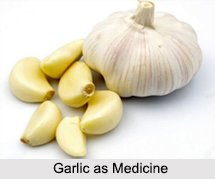 Garlic is botanically named as Allium Sativum. For hundreds of years, garlic has been renowned for its usefulness in treating a whole range of ailments. Most of the health benefits of garlic come from the sulphur containing compounds.
Garlic is botanically named as Allium Sativum. For hundreds of years, garlic has been renowned for its usefulness in treating a whole range of ailments. Most of the health benefits of garlic come from the sulphur containing compounds.
Benefits of Garlic
Garlic is described as carminative, stomachic, alterative, tonic and useful in affections of the nervous system, flatulence, hysteria, etc. During its use, the diet should consist of wine, meat and acids.
Dose of Garlic in Medicine
Decoction of garlic is prepared by taking garlic 32 tolas, water 4 seers and milk 4 seers, boil together till the water is evaporated and strained. This decoction in milk is given in small doses in hysteria, flatulence, sciatica and heart disease.
Svalparasuna Pinda: Take garlic 12 tolas, asafoetida, cumin seeds, rock salt, sonchal salt, ginger, long pepper and black pepper, each one-eighth of a tola; powder them finely and mix. Dose should be about 22 grains every morning with a decoction of the root of the castor oil plant, in facial paralysis, hemiplegia, sciatica, paraplegia and convulsive affections. This medicine should be continued for a month.
Garlic juice slightly warmed is used as a local application in otalgia. A bulb of garlic is sometimes introduced into the meatus for relief of pain in the internal ear.
This article is a stub. You can enrich by adding more information to it. Send your Write Up to content@indianetzone.com




















